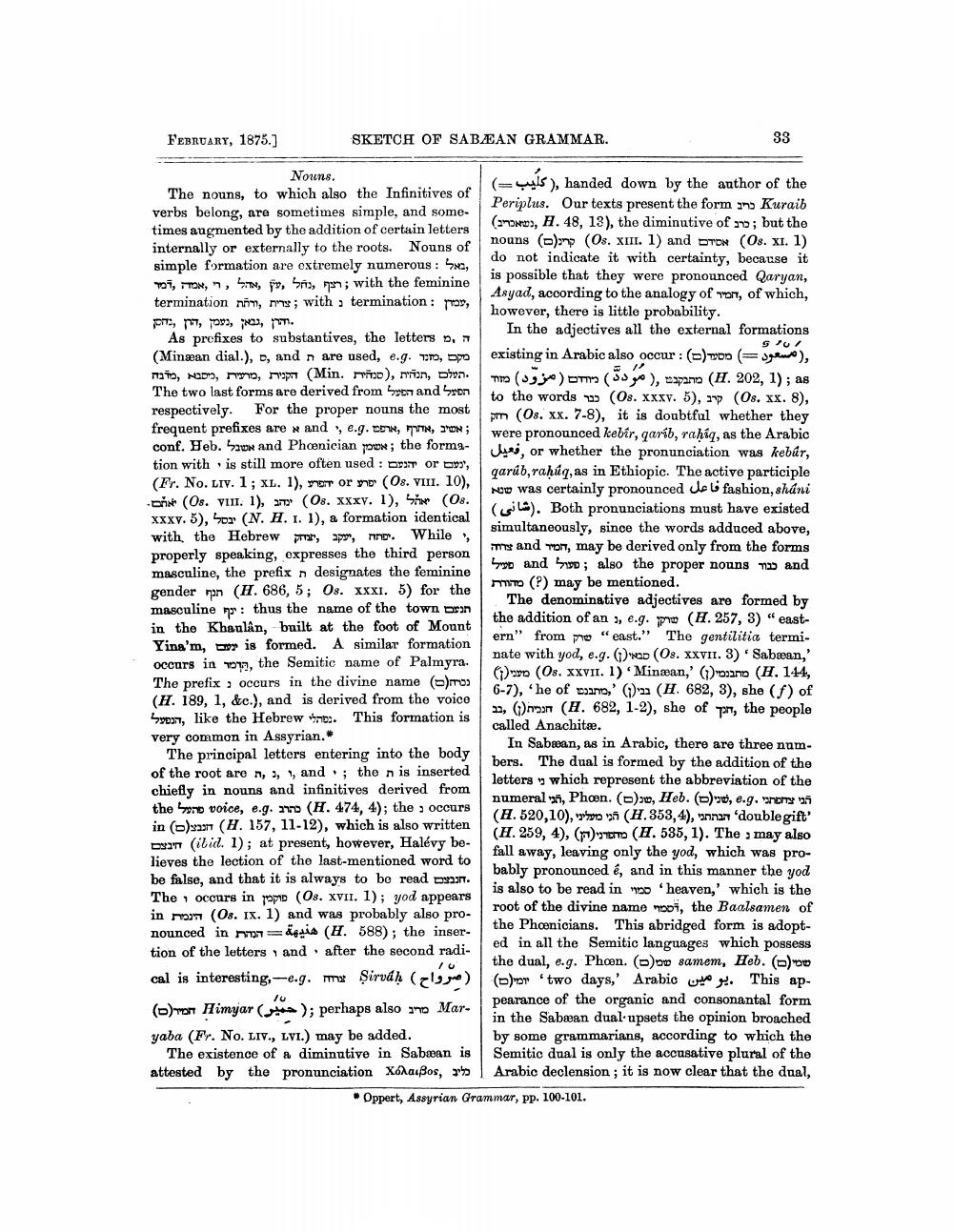________________
FEBRUARY, 1875.]
SKETCH OF SABAAN GRAMMAR.
הפעל and הפעל The two last forms are derived from
,'נעם or יהנעם : tion with is still more often used
and כבור also the proper nouns ; סעול and פעיל
Nouns.
(=vuls), handed down by the author of the The nouns, to which also the Infinitives of verbs belong, are sometimes simple, and some
Periplus. Our texts present the form in Kuraib
(30V, H. 48, 13), the diminutive of 0; but the times augmented by the addition of certain letters internally or externally to the roots. Nouns of
nouns (o) (Os. XIII. 1) and DTON (08. XI. 1) simple formation are oxtremely numerous: bra,
do not indicate it with certainty, because it WT, TON, , , , , ; with the feminine
is possible that they were pronounced Qaryan, termination non, my; with , termination : pop,
Asyad, according to the analogy of non, of which,
however, there is little probability. PIT, 77, 70, 72, 79. As profixes to substantives, the letters ,
In the adjectives all the external formations (Minaan dial.), D, and n are used, e.g. uro, sp existing in Arabic also occur : () TOD (= Syro), maño, Na, o rap (Min. o), win, bhon. mm (930) TT (58 yo ), pano (H. 202, 1); as
to the words (Os. xxxv. 5), 2 (08. XX. 8), respectively. For the proper nouns the most
pm (Os. xx. 7-8), it is doubtful whether they frequent prefixes are * and e.g. N, TN, SON;
were pronounced kebir, qarib, rahíq, as the Arabic conf. Heb. Sad and Phoenician poor; the form -
Jyri, or whether the pronunciation was kebar,
qarúb,rahúq, as in Ethiopic. The active participle (Fr. No. Liv. 1 ; XL. 1), mor or n (Os. VIII. 10),
new was certainly pronounced us li fashion, shuni Dňa (Os. VIII. 1), aty (Os. xxxv. 1), S (Os.
(sjL). Both pronunciations must have existed xxxv. 5), 2 (N. H. 1. 1), a formation identical with the Hebrew pror, apor, nime. While
simultaneously, since the words adduced above,
and Ton, may be derived only from the forms properly speaking, expresses the third person masculine, the prefix n designates the feminine
MITO (?) may be mentioned. gender man (H. 686, 5; 08. XXXI. 5) for the masculine my: thus the name of the town brin
The denominative adjectives are formed by in the Khanlân, built at the foot of Mount
the addition of an 3, e.g.p (H. 257, 3) "eastYina'm, ey is formed. A similar formation
ern" from me "east." The gentilitia termi
nate with yod, e.g. (1) Had (Os. XXVII. 3) Sabwan,' occurs in py, the Semitic name of Palmyra.
61) en (Os. XXVII. 1) Minæan,' (1) 'ono (H. 144, The prefix occurs in the divine name (mo (H. 189, 1, &c.), and is derived from the voice
6-7), 'he of man,' (1) 2 (H. 682, 3), she (f) of 2, 1) (H. 682, 1-2), she of pn, the people
called Anachitæ. very common in Assyrian.*
In Sabman, as in Arabic, there are three numThe principal letters entering into the body
bers. The dual is formed by the addition of the of the root are n, 2, 1, and ; the n is inserted
letters, which represent the abbreviation of the chiefly in nouns and infinitives derived from
numeral 26, Phen. (b), Heb. (), e.g. mmg 37 the sono voice, e.g. 1 (H. 474, 4); the occurs
(H. 520,10), o vn (H. 353,4), an 'double gift' in ()xa (H. 157, 11-12), which is also written
(H. 259, 4), (F) (H. 535, 1). The ; may also sam (ibid. 1); at present, however, Halévy believes the lection of the last-mentioned word to
fall away, leaving only the yod, which was probe false, and that it is always to be read an.
bably pronounced é, and in this manner the yod The occurs in op (Os. XVII. 1); yod appears
is also to be read in 'heaven,' which is the in 3 (Os. Ix. 1) and was probably also pro
root of the divine name moi, the Baalsamen of nounced in dosis (H. 588); the inser
the Phoenicians. This abridged form is adopttion of the letters and after the second radi
ed in all the Semitic languages which possess
the dual, e.g. Phoen. ( v samem, Heb. (c) cal is interesting, -e.g. my Şirvah ( go) ( or two days,' Arabic . This ap
pearance of the organic and consonantal form () mor Himjar ( ); perhaps also go Mar
in the Sabwan dual-upsets the opinion broached yaba (Fr. No. LIV., LVI.) may be added.
by some grammarians, according to which the The existence of a diminutive in Sabæan is Semitic dual is only the accusative plural of the attested by the pronunciation Xóaußos, ' Arabic declension; it is now clear that the dual,
* Oppert, Assyrian Grammar, pp. 100-101.
This formation is .נפתלי like the Hebrew ,הנפעל




